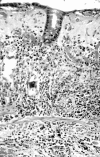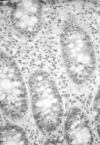Pathology of drug-associated gastrointestinal disease
- PMID: 14651719
- PMCID: PMC1884388
- DOI: 10.1046/j.1365-2125.2003.01980.x
Pathology of drug-associated gastrointestinal disease
Abstract
A large number of drugs have gastrointestinal side-effects of which diarrhoea or constipation, nausea and vomiting are amongst the commonest. In relatively few are there diagnostic pathological changes and this review draws attention to the most common. Incriminating a drug as a cause of specific pathological changes requires the drug to be associated with the changes, for the latter to resolve when the drug is withdrawn and for them to re-appear when a patient is rechallenged with the drug. Individual histological features such as apoptosis, tissue infiltration by eosinophils and increased intra-epithelial lymphocytes within the gut mucosa can be clues to an iatrogenic aetiology but these are by no means specific. Amongst the few pathognomonic patterns of drug reactions is pseudomembranous colitis and diaphragm disease. These, along with others such as reactive gastritis and the collagenous and lymphocytic forms of microscopic colitis, in which drugs have also been implicated, are described here.
Figures







References
-
- Lee FD. Drug related pathological lesions of the intestinal tract. Histopathology. 1994;24:303–308. - PubMed
-
- Warren BF, Shepherd NA. Iatogenic pathology of the gastrointestinal tract. In: Kirkham N, Hall P, editors. Progress in Pathology. Edinburgh: Churchill Livingstone; 1995. pp. 31–54. 1.
-
- Ghadially FN, Walley VM. Melanoses of the gastrointestinal tract. Histopathology. 1994;25:197–207. - PubMed
Publication types
MeSH terms
Substances
LinkOut - more resources
Full Text Sources

